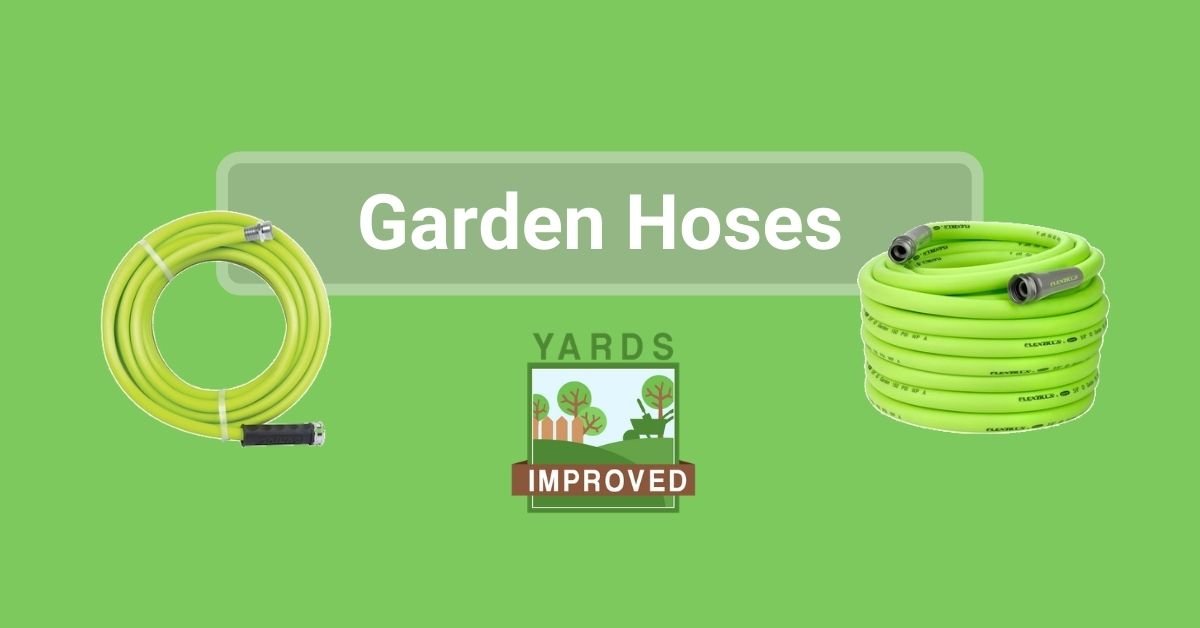A garden hose is a basic part of your supplies. It helps you get water to your flowers, plants, grass, and trees. But it also does so much more! You need it for washing the car, cleaning the siding, and filling the pool.
How To Choose A Garden Hose
Not all hoses are created equal, however. It’s important to choose one that will get the water where you need it. That means it has to be durable enough not to leak. It should survive being stepped on or even driven over. And of course, it has to be long enough to get from the spigot to where you want the water to end up!
Let’s start with length. Hoses generally come in 50- or 100-foot lengths. You want to be sure to have enough to reach the areas you need it, with a little slack. However, there’s no benefit to getting a hose too long for your needs. It only becomes a bigger hassle to try to store it. If you usually need a 50-foot hose and only on rare occasions need more, it could be best to connect shorter lengths. Or you could have a longer hose that you only connect when needed.
Material is another factor to consider. Hoses are usually made from vinyl or rubber. Rubber is the best bet. It will hold up longer and be more resistant to cracking. Even when reinforced with mesh, vinyl is less durable. Vinyl can be a decent budget option, but don’t expect it to hold up over time. Rubber-vinyl blends are better, but all-rubber hoses are the best choice. Some hoses have multiple layers, too, but the material matters here, too.
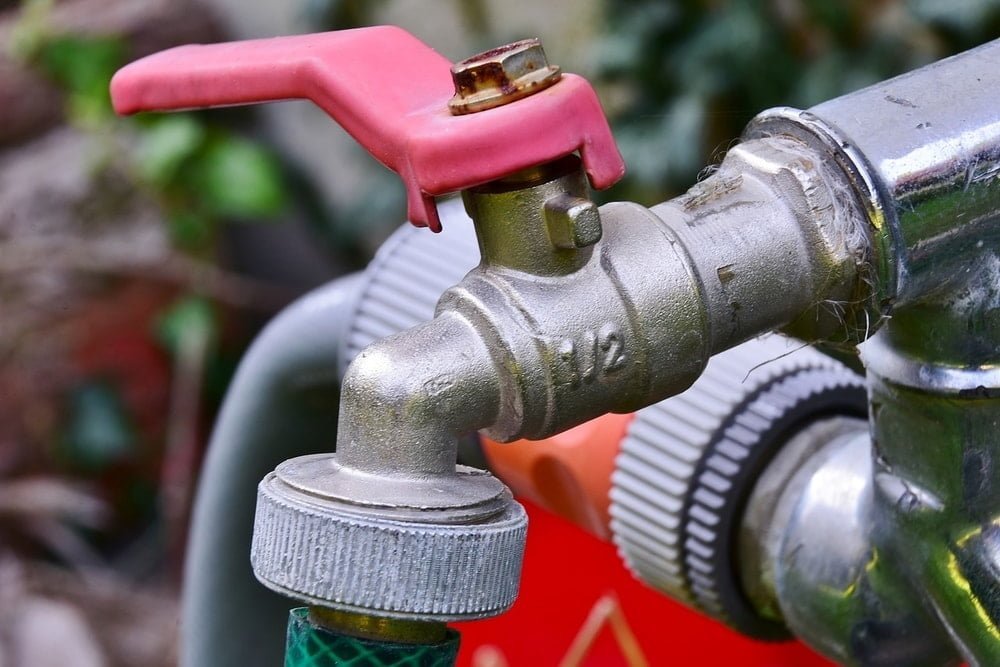
There are also metal hoses. These are usually high-quality, and expensive. We won’t be looking at them in this article, but we want to acknowledge their existence, of course!
The diameter of your hose matters, too. This determines how fast water comes out and how much pressure it has. A typical hose is between ½ and ¾ inches in diameter – ⅝ inch, halfway between those, is often common. A smaller diameter, like ½ inch, means less water will come out over the same amount of time, but it’s under higher pressure. A ¾-inch hose has lower pressure but water comes out more quickly. That makes ⅝-inch a good balance.
Kinking is when a hose bends and blocks the water flow – a problem you don’t want to face when you’re trying to get a job done! All hoses, even those labeled “kink-free”, can get these bends in them. Better hoses will be more resistant to kinks, though. So look for a hose that won’t easily bend to the point of blocking water flow.
You also want to be sure the hose is strong enough to support the pressure of water flowing through it. If you use a sprinkler or nozzle on the end of your hose, some pressure will build up. If you use your hose with a power washer, there’s even more pressure. “Burst pressure” is the name usually given to this rating. A burst rating of 350 psi is enough for general use but for power washers or any other high-pressure use, you should look for higher psi.
The couplers on the ends of your hose are also important. They are either made of plastic or metal. Metal is the best choice here. It will hold up longer and is less likely to crack or leak.
Of course, the quality materials here also weigh more than the inferior ones. A good rubber hose with metal couplers is heavier than a cheap vinyl one with plastic couplers. And that has to be taken into account, too, because you’ll need to carry and store the hose. If you can handle the weight, though, it’s worth it.
While you’re at it, check out what other tools you should have for your garden!
How To Care For A Garden Hose
Quality materials won’t matter, though, if you don’t take good care of your hose. Fortunately, it’s not complicated.
We did mention above that you want a hose that will stand up to be driven over. Of course, you don’t want to make that a common practice. Yes, a good hose will hold up to accidentally being run over. But no, it’s not designed to regularly support this kind of abuse.
While a hose can be left stretched out, it’s usually best to coil it after use. You can coil it by hand, but there are also several easier ways.
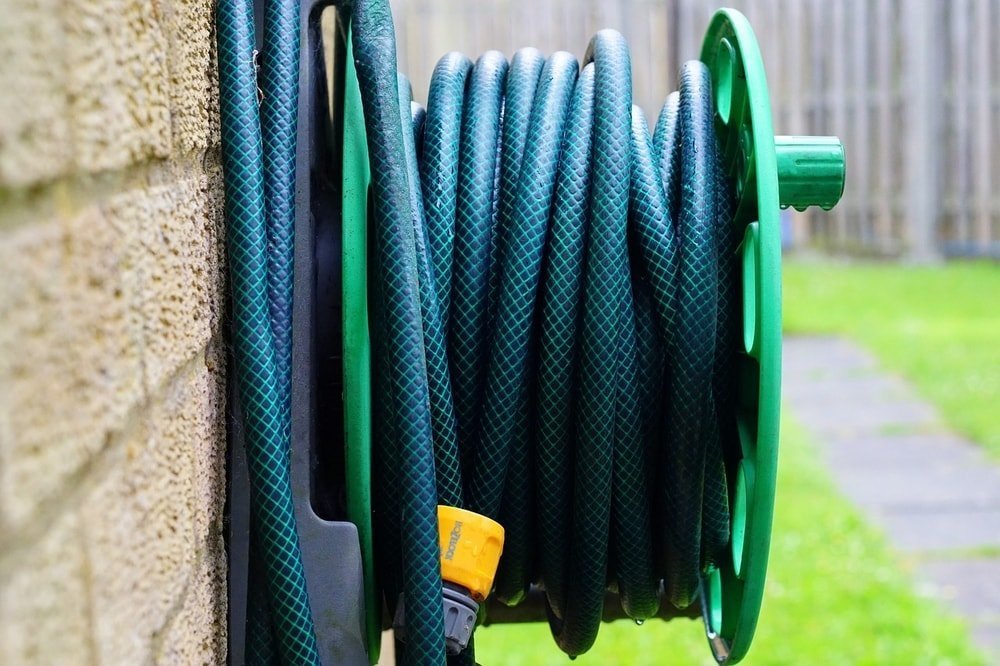
If you’re going to coil by hand, first make sure the water is turned off. Then start at the end nearest the spigot. Make a loop about three feet across and lay it on the ground, grabbing the hose a couple of feet after the loop. Continuing making loops of the same size, laying each one on top of the last. You can leave the coiled hose on the ground or hang it on a strong hook.
A hose pot is a great storage unit for a hose. You can coil the hose inside the pot. This keeps the loops more consistent and hides the hose from view with a stylish container.
Hose reels are another great alternative – you just have to turn the handle and the hose will coil itself on the reel. This helps avoid dealing with the mess and the weight since the reel usually has handles and small wheels to let you roll it out of the way.
Winter Storage
Before the cold weather sets in, it’s important to store your hose out of the elements. There’s not much more involved here.
We recommend that you inspect your hose for leaks before storing it. There are patch kits for hoses, but it’s often just as economical to replace the hose. Checking for leaks is as simple as running water through the hose, preferably with a closed nozzle at the end.
Check the washers in the couplers, too. If they’re looking worn or cracked, replace them.
It’s best to do the check-in the fall so that you can fix or replace the hose over winter. That means you won’t be caught off-guard when spring rolls around – and you might be able to find better prices in the off-season!
Be sure to drain the water from your hose before storing it. Remove any attachments and coil it, allowing the water to drain out the end. It’s best to keep it off cold floors, so hang it, leave it on the hose reel, or place it on top of something so the low temperatures won’t damage it.
Our Picks for the Best Garden Hoses
As you can imagine, there are all kinds of hoses out there. They run the gamut in terms of price and quality. But we’ve picked out some of the best. Here are our choices.
Flexzilla 5/8 in. x 100 ft. ZillaGreen Garden Hose with 3/4 in. GHT Fittings
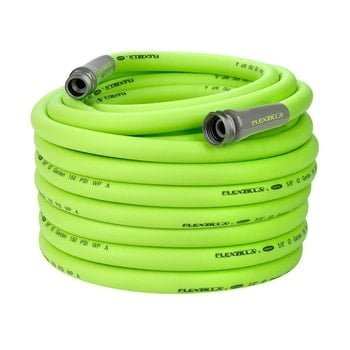
Flexzilla offers this ⅝” hose that’s advertised as “no kinks”, although as we noted above, that’s always an exaggerated claim. However, most people don’t report any major problems with this hose.
The hose holds up well to temperature extremes and retains its flexibility even when it’s near freezing out.
The couplers are aluminum and seem durable enough. We’re not sure of the material since it’s listed as “other”. However, from other research, it seems to be a rubber polymer mixed with plastic. It does seem to hold up as well as rubber, though.
The burst pressure for this hose is 500 psi, making it suitable for nearly any home use, including with most pressure washers.
The hose weighs 11.4 pounds. That’s a couple of pounds lighter than other 100-foot hoses, although it’s still a good amount of weight. But you might not be able to beat it.
While our link goes right to the 100-foot version, there are also shorter lengths available, all the way down to 3 feet. There are buttons at the link to choose your size.
Scotts MaxFlex 5/8 in. x 100 ft. Heavy Garden Hose
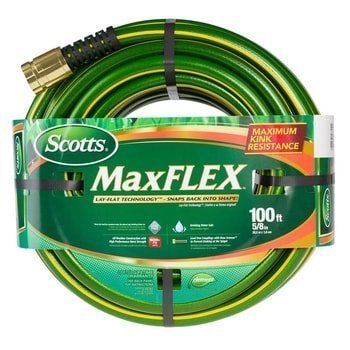
Here’s another quality 100-foot hose, this time from Scotts. We do prefer their advertising – they say it’s “kink-resistant” and don’t make any claims that it won’t ever kink. That’s a much more realistic assessment, and it’s a true one: this hose holds up well and doesn’t kink easily.
This is a rubber polymer hose that has a “patented hose armor” to help prevent kinking and damage to the hose. It also has a 500 psi burst pressure, meaning it will hold up well to the pressure inside it, as well.
The hose weighs just over 14 pounds, a good bit more than the Flexzilla model above.
The couplers are aluminum.
Some users say the hose tends to loop or have other issues when trying to put it on a hose reel. This seems to be due to its thickness.
Scotts says the hose meets federal guidelines for drinking water safety, too.
Continental Premium 5/8 in. Dia x 50 ft. Commercial Grade Rubber Black Water Hose
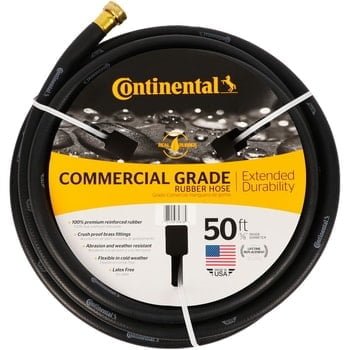
Moving to 50-foot hoses, this is a great one from Continental.
Weighing in at a hefty 12 pounds (remember, this is only 50 feet, compared to the 100-foot hoses above), this rubber hose is not only heavy-duty but also heavy. However, it is quite durable and you can expect it to last quite a while. It has a limited lifetime warranty.
The burst pressure is 400 psi, which is slightly lower than the ones we reviewed above, but still sufficient for almost all household needs.
The couplers are made of brass, making them highly dependable.
This hose does seem comparatively expensive – even though it’s 50 feet long, the price is comparable to that of many 100-foot hoses. However, the quality materials help explain the cost.
Neverkink 5/8 in. Dia x 50 ft. Garden Hose
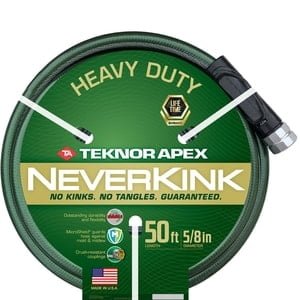
Here, even the brand name probably goes a little beyond what could be guaranteed, since any hoses could kink under the right circumstances. However, this hose does, like the others we’ve chosen to review, mainly resist kinks and other issues, especially when full of water.
This hose is, again, ⅝” in diameter. The threads are brass. It also has “ergonomic grips” – these reinforced areas behind the couplings do make it a bit easier to grasp the hose while hooking it up.
The entire thing weighs a comfortable 8 pounds, making it easy to carry around when necessary.
The burst pressure is only 340 psi. That’s good for general garden use, but is a bit lower than most other hoses – and the lowest of those we’ve reviewed. Again, it’s good for general use, though.
Sun Joe Aqua Joe 1/2 in. Dia. x 50 ft. Heavy Duty, Kink-Resistant, Lightweight Garden Hose, Lead-free, BPA-Free
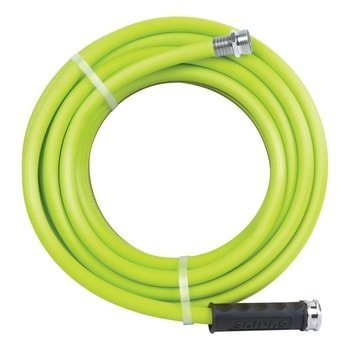
We’ve decided to include this ½”-inch hose from Sun Joe in our list, too, because it is a quality piece and there may be times when you need a narrower hose, too.
This hose is made of rubber and has zinc couplers. Its smaller diameter means it weighs less than larger hoses – it comes in at just over 4 pounds. Still, it does have a 400 psi burst pressure, meaning it will hold up just fine.
It seems to kink a bit more than other hoses here. Partly, that may be because of the smaller diameter.
If you’re looking for a ½” hose for any reason, this is a good choice.
Conclusion
A good garden hose is an important tool. It helps with watering and other uses as well. It’s important to consider the materials, weight, and other factors before making your purchase. We hope our reviews here help you find a great garden hose that meets your needs!

